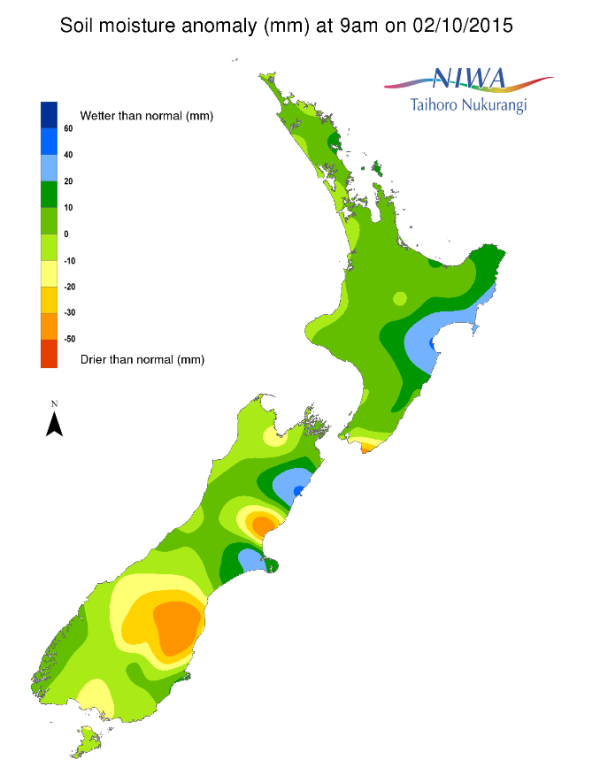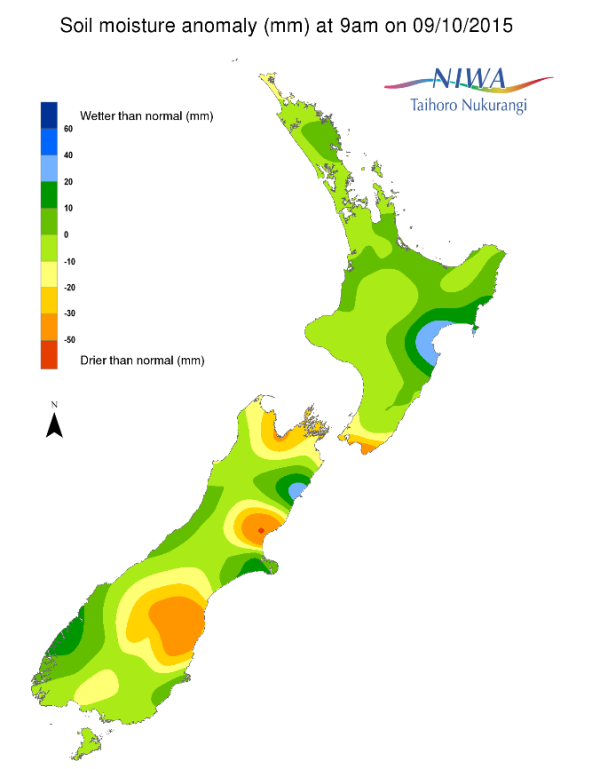A weekly update describing soil moisture across the country to help assess whether severely to extremely dry conditions are occurring or imminent. Regions experiencing these soil moisture deficits are deemed “hotspots”. Persistent hotspot regions have the potential to develop into drought.
Facts: Soil Moisture
Soil moisture levels for the majority of the North Island remain in the near normal range for this time of year with very little change from this time last week. The exception to this are coastal parts of South Wairarapa where soil moisture levels have continued to decrease over the past week and below normal soil moisture levels now extend to Lower Hutt. The effects of widespread and heavy rain in the Hawke’s Bay during September are still evident in the soil moisture levels for the region which are wetter than normal for this time of year. This area of wetter than normal soil has contracted when compared to last week.
In the South Island, soil moisture levels are much drier to severely drier than normal for this time of year for northeastern Otago as well as for northern and southern sections of eastern Canterbury. Over the past week, this area of severe to extreme dryness has continued to grow. Drier than normal soils present in the rest of Otago and southeastern Southland last week have persisted throughout this week. Additionally, drier than normal soils for this time of year have continued to develop in the Nelson, Tasman and Marlborough regions. Pockets of wetter than normal soil moisture for this time of year are present in the district of Kaikoura. The rest of the island is experiencing near normal soil moisture levels for this time of year.
Outlook
For the North Island, very little rain is forecast for the week ahead. A predominantly westerly to southwesterly wind flow will contain scattered showers to western parts of the island with only one frontal passage expected mid-week to bring more widespread rain. Consequently, it is likely that soil moisture levels will decrease by next Friday for eastern areas of the island and drier than normal soils around South Wairarapa could extend further. These impacts should not be significant with the majority of the island maintaining near normal soil moisture levels.
For the South Island, showers will largely remain west of the Divide with more significant rainfall associated with a front forecast for mid-week. This front may alleviate some of the dryness developing in the Tasman region but at this point in time there is still some uncertainty related to how far inland the rain will extend. East of the Divide, weekly rainfall is likely to be near or below normal. As result soil moisture levels are likely to decrease over the next seven days in these areas.
Overall, a hotspot persists in north and northeast Otago through to southern sections of east Canterbury. Another hotspot is located in north-central parts of eastern Canterbury, roughly north of Christchurch and south of the Waiau River.
Background:
Hotspot Watch a weekly advisory service for New Zealand media. It provides soil moisture and precipitation measurements around the country to help assess whether extremely dry conditions are imminent.
Soil moisture deficit: the amount of water needed to bring the soil moisture content back to field capacity, which is the maximum amount of water the soil can hold.
Soil moisture anomaly: the difference between the historical normal soil moisture deficit (or surplus) for a given time of year and actual soil moisture deficits.
Definitions:
“Extremely” and “severely” dry soils are based on a combination of the current soil moisture status and the difference from normal soil moisture (see soil moisture maps at https://www.niwa.co.nz/climate/nz-drought-monitor/droughtindicatormaps)
Soil Moisture Anomaly Maps
Pictured below Soil Moisture Anomaly Maps, relative to this time of year. On the left are values this time last week. On the right are the most recent values.


